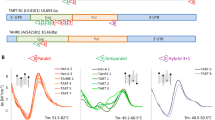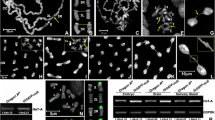Abstract
Telomeres of Drosophila appear to be very different from those of other organisms. A transposable element, HeT-A, plays a major role in forming telomeres and may be the sole structural element, since telomerase-generated repeats are not found. HeT-A transposes only to chromosome ends. It appears to be a retrotransposon but has novel structural features, which may be related to its telomere functions. A consensus sequence from cloned HeT-A elements defines an element of ∼6 kb. The coding region has retrotransposon-like overlapping open reading frames (ORFs) with a −1 frameshift in a sequence resembling the frameshift region of the mammalian HIV-1 retrovirus. Both the HeT-A ORFs contain motifs suggesting RNA binding. HeT-A-specific features include a long non-coding region, 3′ of the ORFs, which makes up about half of the element. This region has a regular array of imperfect sequence repeats and ends with oligo(A), marking the end of the element and suggesting a polyadenylated RNA transposition intermediate. This 3′ repeat region may have a structural role in heterochromatin. The most distal part of each complete HeT-A on the chromosome, the region 5′ of the ORFs, has unusual conserved features, which might produce a terminal structure for the chromosome.
Similar content being viewed by others
References
Bairoch A (1993) The PROSITE dictionary of sites and patterns in proteins, its current status. Nucleic Acids Res 21: 3097–3103
Biessmann H, Carter SB, Mason JM (1990a) Chromosome ends in Drosophila without telomeric DNA sequences. Proc Natl Acad Sci USA 87: 1758–1761
Biessmann H, Mason JM, Ferry K, d'Hulst M, Valgeirsdottir K, Traverse KL, Pardue ML (1990b) Addition of telomere-associated HeT DNA sequences “heals” broken chromosome ends in Drosophila. Cell 61: 663–673
Biessmann H, Champion LE, O'Hair M, Ikenaga K, Kasravi B, Mason JM (1992a) Frequent transposition of Drosophila melanogaster HeT-A elements to receding chromosome ends. EMBO J 1: 4459–4469
Biessmann H, Mason JM, Ferry K, D'Hulst M, Valgersdottir K, Lofsky A, Chin C, Ginther B, Levis RW, Pardue M-L (1992b) HeT-A, a transposable element specifically involved in “healing” broken chromosome ends in Drosophila. Mol Cell Biol 12: 3910–3918
Boeke JD, Corces VG (1989) Transcription and reverse transcription of retrotransposons. Annu Rev Microbiol 43: 403–434
Blackburn EH (1990) Telomeres and their synthesis. Science 249: 489–490
Corpet F (1988) Multiple sequence alignment with hierarchical clustering. Nucleic Acids Res 16: 10881–10890
Danilevskaya ON, Petrov DA, Pavlova MA, Koga A, Kurenova EV, Hartl DL (1992) A repetitive DNA element, associated with telomeric sequences in Drosophila melanogaster, contains open reading frames. Chromosoma 102: 32–40
Danilevskaya O, Lofsky A, Kurenova EV, Pardue M-L (1993) The Y chromosome of Drosophila melanogaster contains a distinctive subclass of HeT-A-related repeats. Genetics 134: 531–543
Devereux J, Haeberli P, Smithies O (1984) A comprehensive set of sequence analysis programs for the VAX. Nucleic Acids Res 12: 387–395
Grinblat Y, Brown NH, Kafatos FC (1989) Isolation and characterization of the Drosophila translation elongation factor gene. Nucleic Acids Res 17: 7303–7314
Luan DD, Korman MM, Jacubczak JL, Eickbush TM (1993) Reverse transcription of R2Bm RNA is primed by a nick at the chromosomal target bite: a mechanism for non-LTR retrotransposition. Cell 72: 595–605
Lundblad V, Blackburn EH (1993) An alternative pathway for yeast telomere maintenance rescues est1-senescence. Cell 73: 347–360
Mason JM, Strobel E, Green MM (1984) mu-2: mutator gene in Drosophila that potentiates the induction of terminal deficiencies. Proc Natl Acad Sci USA 81: 6090–6094
Mitchell PJ, Tjian R (1989) Transcriptional regulation in mammalian cells by DNA binding proteins. Science 245: 371–378
Muller HJ (1938) The remaking of chromosomes Collect Net 13: 181–195
Traverse KL, Pardue ML (1988) A spontaneously opened ring chromosome of Drosophila melanogaster has acquired HeT DNA sequences at both new telomeres. Pro Natl Acad Sci USA 85: 8116–8120
Valgeirsdottir K, Traverse KL, Pardue ML (1990) HeT DNA: a family of mosaic repeated sequences specific for heterochromatin in Drosophila melanogaster. Proc Natl Acad Sci USA 87: 7998–8002
Weiss RB, Dunn DM, Shuh M, Atkins JF, Gesteland RF (1989) E. coli ribosomes re-phase on retroviral frameshift signals at rates ranging from 2 to 50 percent. New Biol 1: 159–169
Wilson W, Braddock M, Adams SE, Rathjen PD, Kingsman SM, Kingsman AJ (1988) HIV expression strategies, ribosomal frameshifting is directed by a short sequence in both mammalian and yeast systems. Cell 55: 1159–1169
Xiong Y, Eickbush TH (1990) Origin and evolution of retroelements based on their reverse transcriptases. EMBO J 9: 3353–3362
Zakian VA (1989) Structure and function of telomeres. Annu Rev Genet 23: 579–604
Author information
Authors and Affiliations
Rights and permissions
About this article
Cite this article
Danilevskaya, O., Slot, F., Pavlova, M. et al. Structure of the Drosophila HeT-A transposon: a retrotransposon-like element forming telomeres. Chromosoma 103, 215–224 (1994). https://doi.org/10.1007/BF00368015
Received:
Accepted:
Issue Date:
DOI: https://doi.org/10.1007/BF00368015




